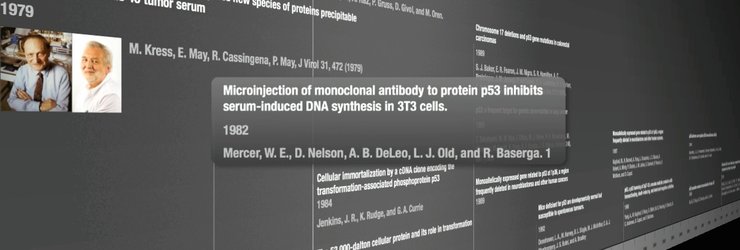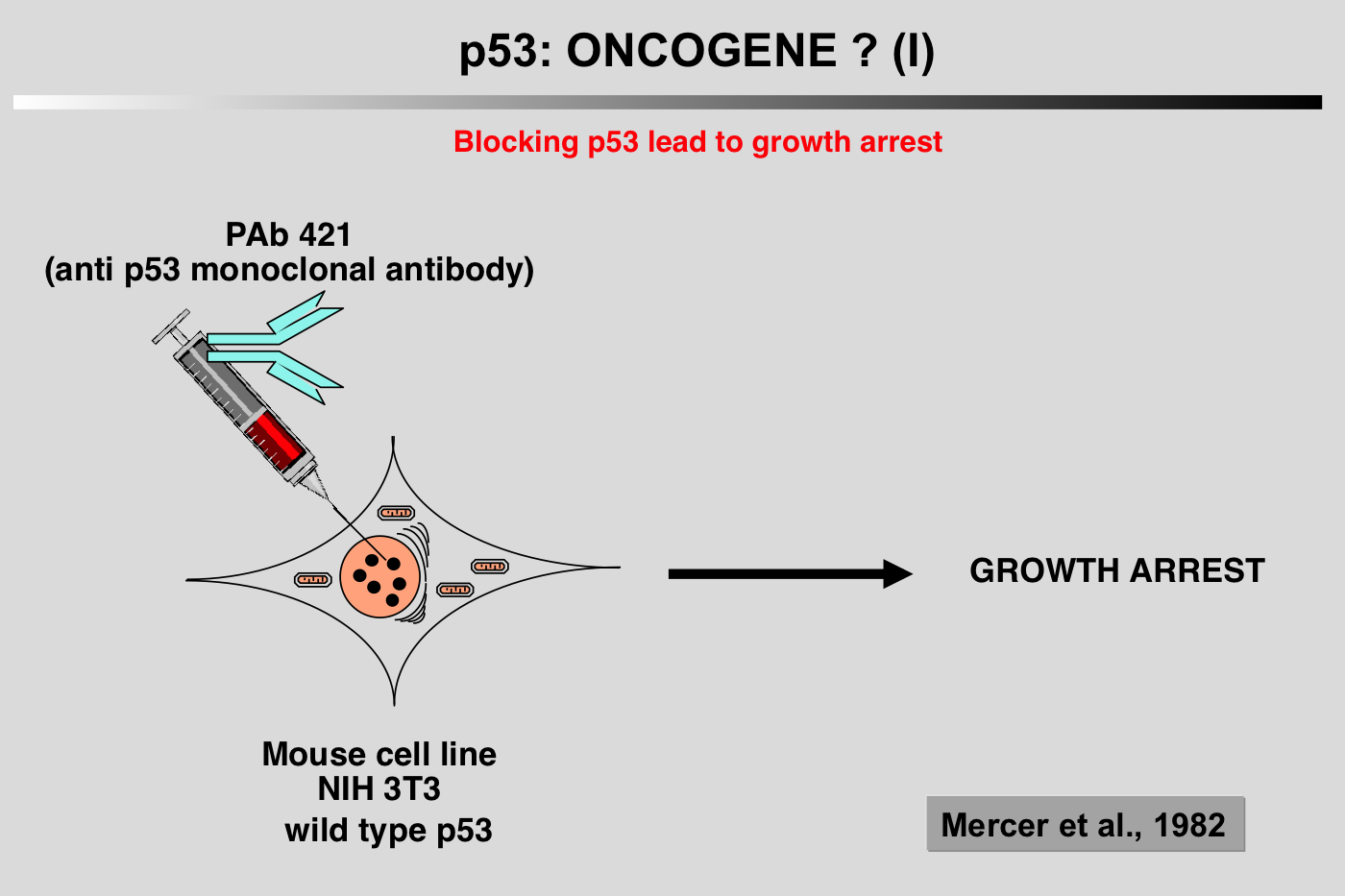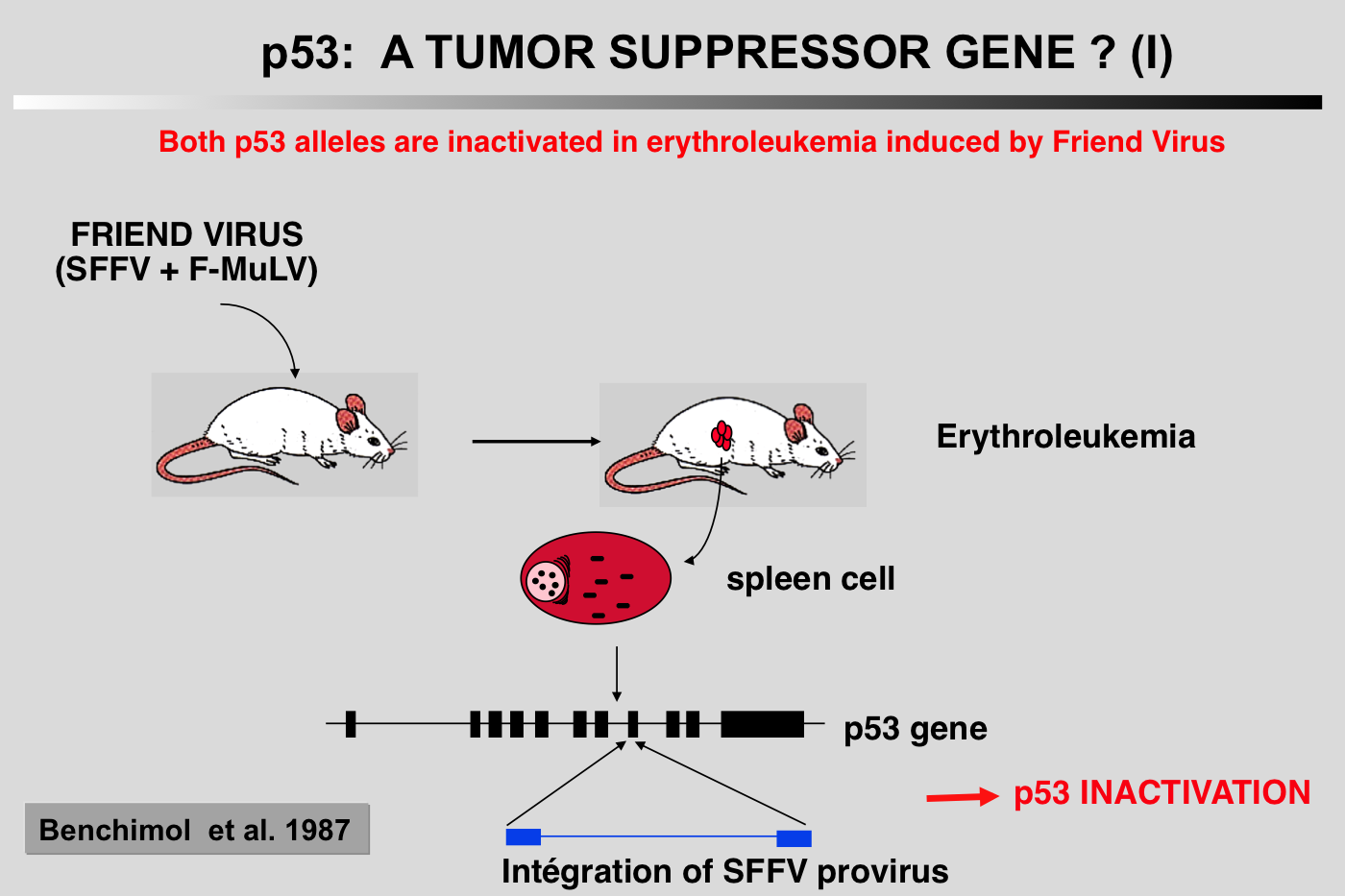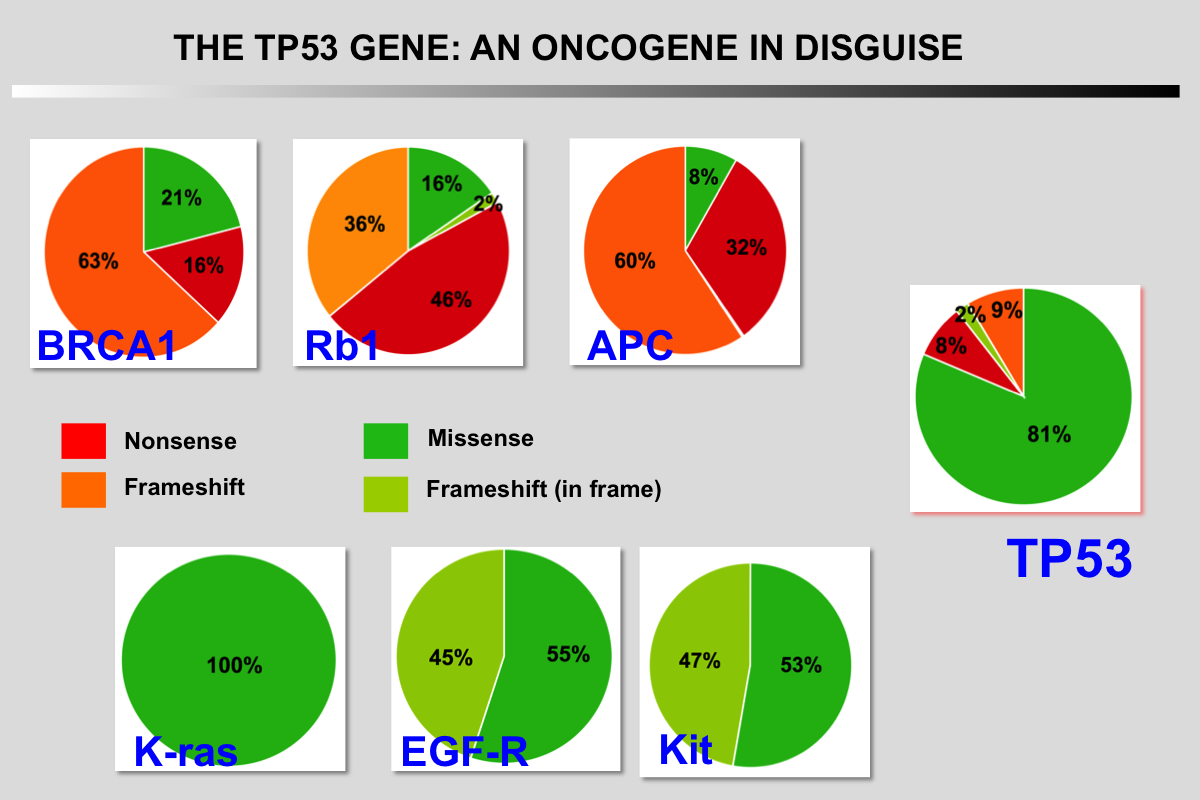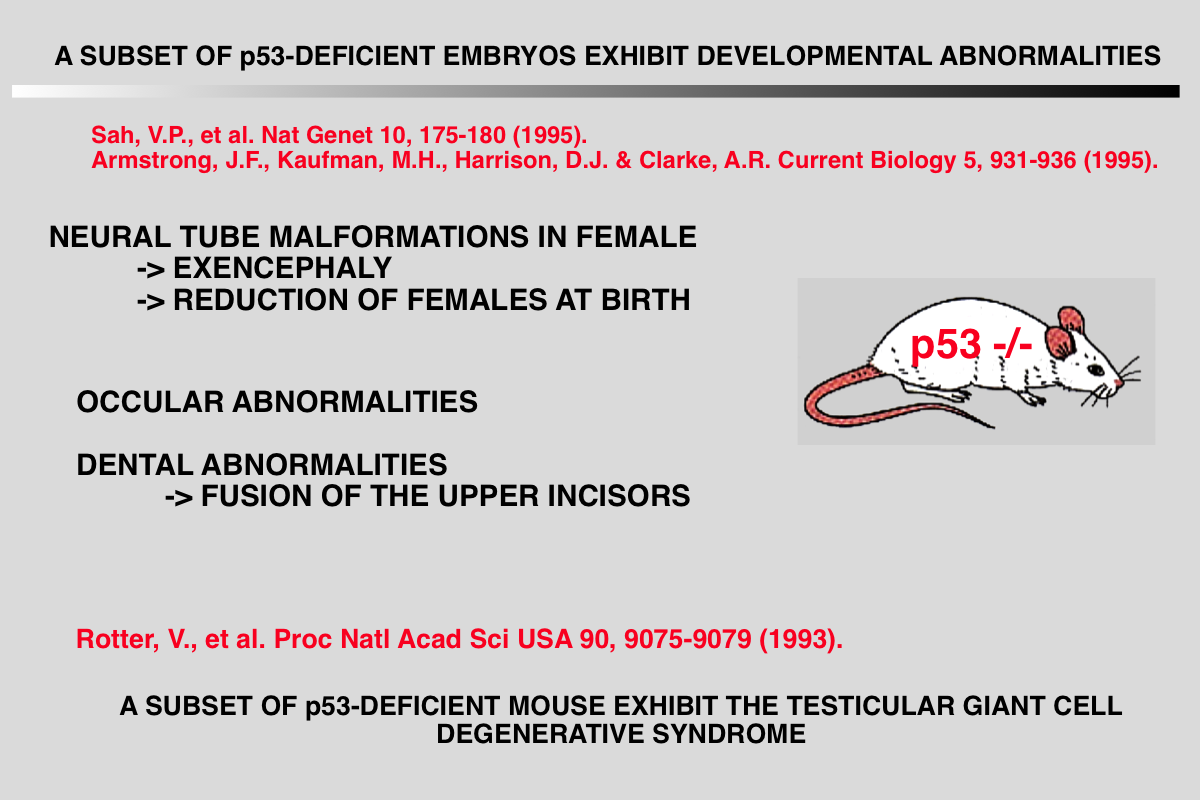The discovery of the p53 protein in 1979 was the culmination of two types of studies: the very well known virological approach, with the binding of p53 protein to oncoviral proteins and the more discrete serological approach with the study of Tumor-Associated Antigens (TAAs).
Click on the links below for further details
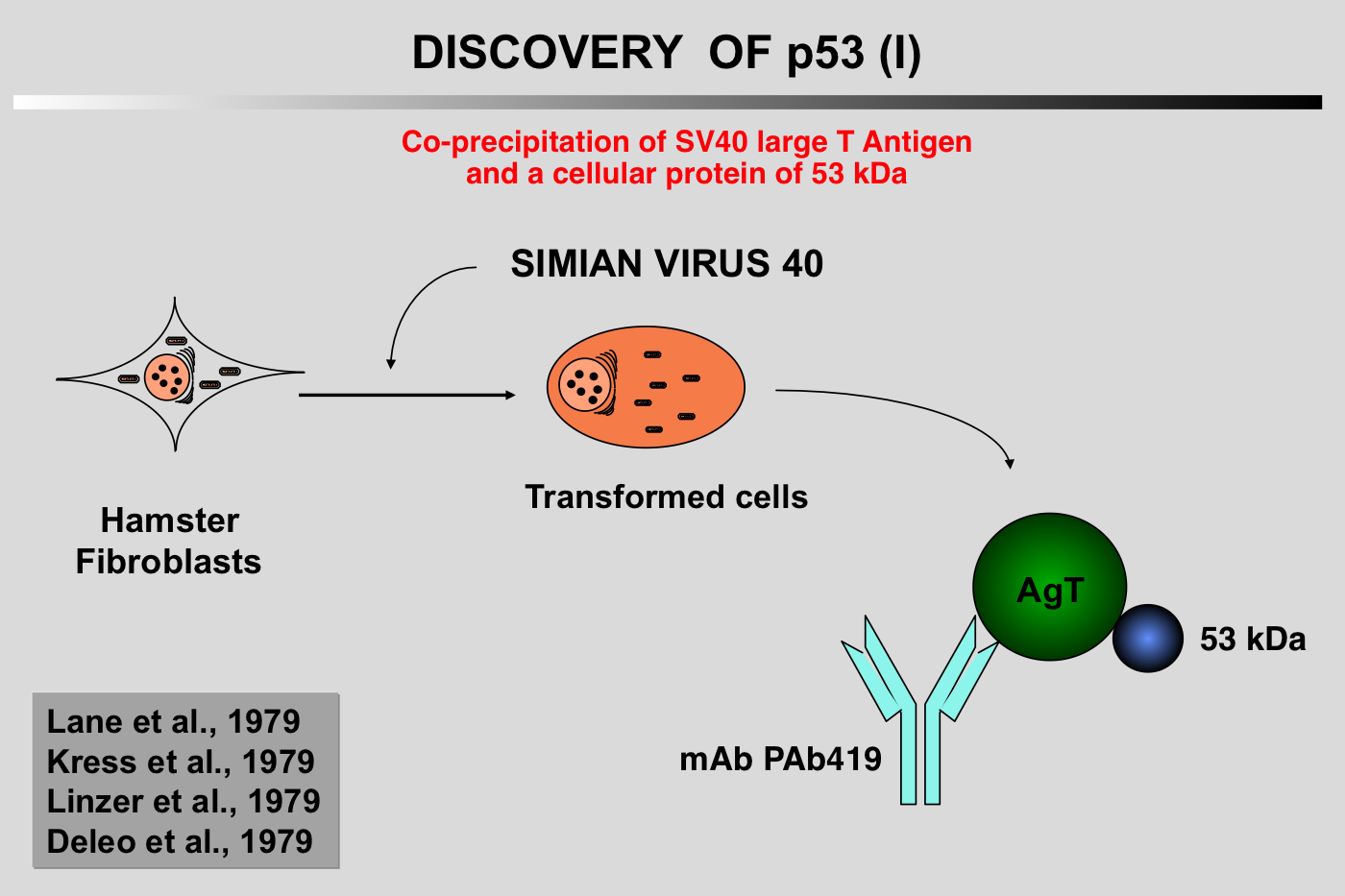 Studies of SV40-transformed cells showed that a 55-kDa protein is coprecipitated with the large-T antigen (Chang et al. 1979; Kress et al. 1979; Lane and Crawford 1979; Linzer and Levine 1979; Melero et al. 1979). This association was shown to be the result of an in vivo association between the two proteins (Lane and Crawford 1979). It was then postulated that this protein could be encoded by the cellular genome. (It should be kept in mind that no middle-T was found for SV40 and that the molecular weight of this protein was similar to that of polyoma middle-T antigen). Linzer and Levine (Linzer and Levine 1979) found that the 54-kDa protein was overexpressed in a wide variety of murine SV40 transformed cells, but also in uninfected embryonic carcinoma cells. A partial peptide map from this 54-kDa protein was identical among the various cell lines, but was clearly different from the peptide map of SV40 large-T antigen (Kress et al. 1979; Linzer and Levine 1979). It was then postulated that SV40 infection or transformation of mouse cells stimulates the synthesis or stability of a cellular 54-kDa protein.
Studies of SV40-transformed cells showed that a 55-kDa protein is coprecipitated with the large-T antigen (Chang et al. 1979; Kress et al. 1979; Lane and Crawford 1979; Linzer and Levine 1979; Melero et al. 1979). This association was shown to be the result of an in vivo association between the two proteins (Lane and Crawford 1979). It was then postulated that this protein could be encoded by the cellular genome. (It should be kept in mind that no middle-T was found for SV40 and that the molecular weight of this protein was similar to that of polyoma middle-T antigen). Linzer and Levine (Linzer and Levine 1979) found that the 54-kDa protein was overexpressed in a wide variety of murine SV40 transformed cells, but also in uninfected embryonic carcinoma cells. A partial peptide map from this 54-kDa protein was identical among the various cell lines, but was clearly different from the peptide map of SV40 large-T antigen (Kress et al. 1979; Linzer and Levine 1979). It was then postulated that SV40 infection or transformation of mouse cells stimulates the synthesis or stability of a cellular 54-kDa protein.
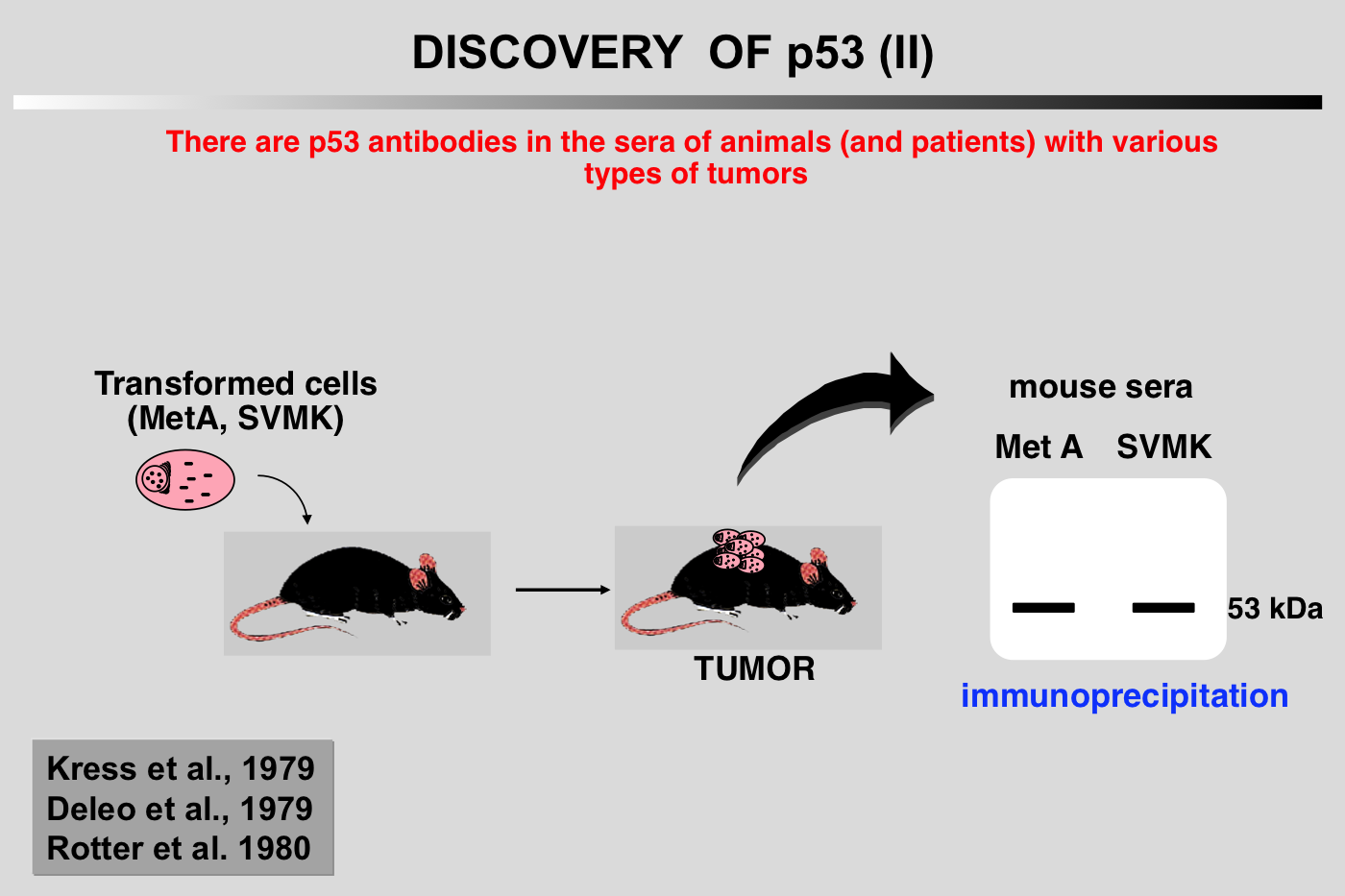 In 1979, DeLeo et al. (De Leo et al. 1979), showed that the humoral response of mice to some methylcholanthrene-induced tumor cell lines such as MethA was directed toward the p53 protein. It was subsequently found that animals bearing several types of tumors elicited an immune response specific for p53 (Kress et al. 1979; Melero et al. 1979; Rotter et al. 1980). In 1982, Crawford et al. (Crawford et al. 1982) first described antibodies directed against human p53 protein in 9% of breast cancer patient sera. No significant clinical correlation was reported, and at that time no information was available concerning mutations of the p53 gene. Caron de Fromentel et al. subsequently found that such antibodies were present in the sera of children with a wide variety of cancers (Caron de Fromentel et al. 1987). The average frequency was 12%, but with a frequency of 20% in Burkitt Lymphoma.
In 1979, DeLeo et al. (De Leo et al. 1979), showed that the humoral response of mice to some methylcholanthrene-induced tumor cell lines such as MethA was directed toward the p53 protein. It was subsequently found that animals bearing several types of tumors elicited an immune response specific for p53 (Kress et al. 1979; Melero et al. 1979; Rotter et al. 1980). In 1982, Crawford et al. (Crawford et al. 1982) first described antibodies directed against human p53 protein in 9% of breast cancer patient sera. No significant clinical correlation was reported, and at that time no information was available concerning mutations of the p53 gene. Caron de Fromentel et al. subsequently found that such antibodies were present in the sera of children with a wide variety of cancers (Caron de Fromentel et al. 1987). The average frequency was 12%, but with a frequency of 20% in Burkitt Lymphoma.
References
Caron de Fromentel C, May-Levin F, Mouriesse H, Lemerle J, Chandrasekaran K and May P (1987) Presence of circulating antibodies against cellular protein p53 in a notable proportion of children with B-cell lymphoma. Int. J. Cancer 39: 185-189.
Chang C, Simmons DT, Martin MA and Mora PT (1979) Identification and partial characterization of new antigens from simian virus 40-transformed mouse cells. J Virol 31: 463-471.
Crawford LV, Pim DC and Bulbrook RD (1982) Detection of antibodies against the cellular protein p53 in sera from patients with breast cancer. Int. J. Cancer 30: 403-408.
Crawford L (1983) The 53,000-dalton cellular protein and its role in transformation. Int. Rev. Exp. Path. 25: 1-50.
De Leo AB, Jay G, Appella E, Dubois GC, Law LW and Old LJ (1979) Detection of a transformation-related antigen in chemically induced sarcomas and other transformed cells of the mouse. Proc Natl Acad Sci USA 76: 2420-2424.
Kress M, May E, Cassingena R and May P (1979) Simian Virus 40-transformed cells express new species of proteins precipitable by anti-simian virus 40 serum. J. Virol. 31: 472-483.
Lane DP and Crawford LV (1979) T antigen is bound to a host protein in SV40-transformed cells. Nature 278: 261-263.
Linzer DIH and Levine AJ (1979) Characterization of a 54 K dalton cellular SV40 tumor antigen resent in SV40-transformed cells and in infected embryonal carcinoma cells. Cell 1: 43-52.
Melero JA, Stitt DT, Mangel WF and Carroll RB (1979) Identification of new polypeptide species (48-55K) immunoprecipitable by antiserum to purified large T antigen and present in simian virus 40-infected and transformed cells. J. Virol. 93: 466-480.
Rotter V, Witte ON, Coffman R and Baltimore D (1980) Abelson murine leukemia virus-induced tumors elicit antibodies against a host cell protein, p50. J Virol 36: 547-555.
Some Reviews (1980-1992)
A must: The birth of p53
Crawford L (1983) The 53,000-dalton cellular protein and its role in transformation. Int. Rev. Exp. Path. 25: 1-50. PDF
• Tooze J (1980) DNA tumor viruses.
• Lane DP and Gannon JV (1983) Cellular proteins involved in SV40 transformation. Cell Biol Int Rep 7: 513-514.
• Oren M (1985) The p53 cellular tumor antigene : gene structure, expression and protein properties. Biochim. Biophys. Acta 823: 67-78.
• Levine AJ (1988) Oncogenes of DNA tumor viruses. Cancer Res. 48: 493-496.
• Levine AJ (1990) The p53 protein and its interactions with the oncogene products of the small DNA tumor viruses. Virology 177: 419-426.
• Lane DP and Benchimol S (1990) p53: oncogene or anti-oncogene? Genes and Development 4: 1-8.
• Levine AJ (1990) Tumor suppressor genes. Bioessays 12: 60-66.
• Levine AJ and Momand J (1990) Tumor suppressor genes - the p53 and retinoblastoma sensitivity genes and gene products. Biochimica et Biophysica Acta 1032: 119-136.
• Soussi T, Caron de Fromentel C and May P (1990) Structural aspects of the p53 protein in relation to gene evolution. Oncogene 5: 945-952.
• Eliyahu D, Michalovitz D, Eliyahu S, Pinhasikimhi O and Oren M (1990) p53 - Oncogene or anti-oncogene. Oncogenes in Cancer Diagnosis 39: 125-134.
• Milner J (1991) A conformation hypothesis for the suppressor and promoter functions of p53 in cell growth control and in cancer. Proc R Soc Lond [Biol] 245: 139-145.
• Levine AJ, Momand J and Finlay CA (1991) The p53 tumour suppressor gene. Nature 351: 453-456.
• Oren M (1991) Role of p53 in neoplasia. Biochemical and Molecular Asp 373-391.
• Michalovitz D, Halevy O and Oren M (1991) p53 mutations - gains or losses. J. Cell. Biochem. 45: 22-29.
• Rotter V and Prokocimer M (1991) p53 and human malignancies. Advances in Cancer Research, 57: 257-272.
• Carbone D (1991) Focusing in on p53 in hepatocellular carcinoma. Hepatology 14: 742-744.
• Hollstein M, Sidransky D, Vogelstein B and Harris CC (1991) p53 mutations in human cancers. Science 253: 49-53.
• Levine AJ (1992) The p53 tumour suppressor gene and product. Cancer Surv 12: 59-79.
• Caron de Fromentel C and Soussi T (1992) TP53 Tumor suppressor gene: a model for investigating human mutagenesis. Genes Chrom. Cancer 4: 1-15.
• Lane D (1992) p53, guardian of the genome. Nature 358: 15-16.
• Vogelstein B and Kinzler KW (1992) p53 function and dysfunction. Cell 70: 523-526.

